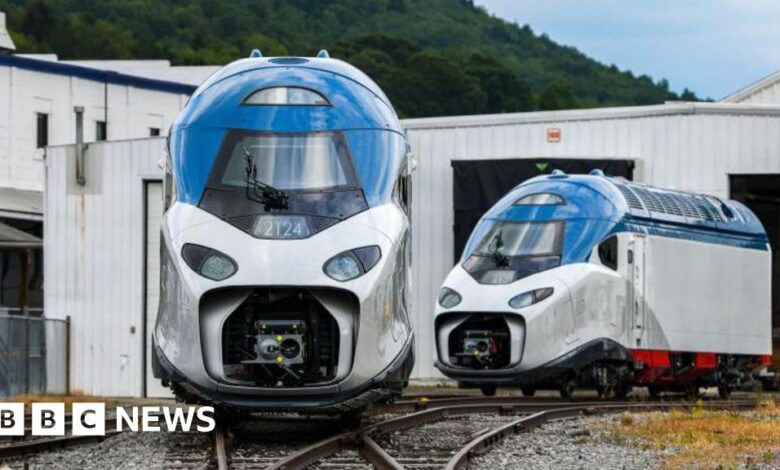Is the US finally on track to build a high-speed rail network?

The United States, a country known for its vast network of highways and airports, has long been lacking in high-speed railways. However, with two high-speed rail projects currently under construction and more in the planning stages, is the US finally ready to catch up with countries like China, Japan, and Europe?
Rick Harnish, from the High Speed Rail Alliance, acknowledges the challenges of building high-speed rail in the US. He points to the San Francisco to Los Angeles route, which faces significant hurdles due to the mountainous terrain in California. On the other hand, the route from Las Vegas to Los Angeles is considered more feasible due to the flat landscape.
In addition to these projects, plans are in place for a high-speed rail line connecting Portland, Oregon, to Seattle, Washington, and Vancouver, Canada. There is also a proposed line between Dallas and Houston. However, progress on these projects has been slow, with funding issues and political obstacles hindering development.
Comparatively, China boasts an extensive high-speed rail network that is set to exceed 50,000 km this year. In Europe, countries like Spain lead the way with thousands of kilometers of high-speed rail lines. In the UK, the High Speed 1 line is operational, while the construction of High Speed 2 continues despite funding challenges.
The definition of high-speed rail, according to the International Union of Railways, involves trains moving at speeds exceeding 250 km/h (155 mph). This standard is used globally to classify high-speed rail systems.
The US’s lag in high-speed rail development can be attributed to various factors, including a strong reliance on cars, lack of public interest, and government reluctance to invest in rail projects. Will Doig, an American rail industry journalist, highlights the nation’s car-centric culture and opposition to rail projects as key barriers to high-speed rail development.
Furthermore, recent developments within Amtrak, the government-owned passenger train service, have added complexity to the high-speed rail landscape in the US. The resignation of CEO Stephen Gardner amid pressure from the White House has raised questions about the future of high-speed rail within the organization.
Despite these challenges, high-speed rail projects are progressing in California and Nevada, with the California High-Speed Rail and Brightline West projects set to transform travel options in the region. With a growing global network of high-speed rail systems, there is increasing pressure for the US to prioritize and invest in high-speed rail infrastructure to keep pace with international standards. China’s high-speed rail (HSR) network is expanding rapidly, with plans to reach a total distance of around 60,000km by 2030. These HSR lines are crucial for connecting cities and boosting economies. According to data from the Denmark-based think tank 21st Europe, cities in China that are linked by HSR experience a 14.2% increase in their economies.
Chinese firms are also involved in building HSR systems in other Asian countries like Indonesia, Malaysia, Thailand, and Vietnam. This expansion of HSR is not just about improving rail networks; it is also a strategic move by China to increase its influence in the region. However, there are concerns about countries becoming financially dependent on China due to loans taken for building these railways.
In contrast, Europe has a well-established HSR network that connects major capitals and cities. There are calls for further expansion of HSR in the EU and the UK to enhance connectivity and promote sustainable transportation. Kaave Pour from 21st Europe emphasizes the importance of investing in public infrastructure for the growth of HSR networks.
In the United States, there are challenges in developing HSR due to a lack of political will and funding. The federal government plays a crucial role in supporting HSR projects, but there have been setbacks like the cancellation of a federal grant for a high-speed line between Houston and Dallas. This decision has raised questions about the government’s commitment to investing in rail transportation.
Scott Sherin, an executive at Alstom, a French train manufacturer, highlights the difficulties of implementing HSR in US cities like Dallas and Houston due to dense urban environments. He questions whether there is enough public support for investing in rail infrastructure over other modes of transportation.
Looking ahead, there is potential for collaboration between China and the US in developing HSR projects. However, political challenges and tensions between the two countries may hinder such partnerships. Will Doig emphasizes the benefits of cooperation between China and the US in building HSR networks and the positive impact it could have on America’s infrastructure development.
Overall, the expansion of HSR networks globally presents opportunities for economic growth, improved connectivity, and sustainable transportation. Collaboration between countries and strategic investments in public infrastructure are essential for realizing the full potential of high-speed rail systems. The COVID-19 pandemic has changed the way we live and work in many ways, and one of the most prominent changes has been the shift to remote work. As companies around the world adapt to the new normal of working from home, many are finding that remote work offers a number of benefits for both employees and employers.
One of the key benefits of remote work is the flexibility it offers. Employees no longer have to commute to the office, saving time and money on transportation costs. This also allows employees to have more control over their work schedules, enabling them to better balance their work and personal lives. This flexibility can lead to increased job satisfaction and improved employee retention rates.
Remote work also has the potential to increase productivity. Without the distractions of a busy office environment, employees may find it easier to focus on their work and complete tasks more efficiently. Additionally, remote work can eliminate the need for unnecessary meetings and allow employees to work in a way that best suits their individual work styles.
Another advantage of remote work is the potential cost savings for employers. By allowing employees to work from home, companies can save on overhead costs associated with maintaining office space. This can lead to significant cost savings, especially for smaller businesses or startups.
Despite these benefits, remote work also presents its own set of challenges. Communication can be more difficult when employees are working remotely, as face-to-face interactions are limited. Employers may need to find new ways to keep their teams connected and engaged, such as utilizing video conferencing tools or implementing regular check-ins.
Additionally, some employees may struggle with the lack of social interaction that comes with working from home. This can lead to feelings of isolation and loneliness, which can impact employee morale and mental health. Employers should make an effort to foster a sense of community among remote workers and provide support for those who may be struggling.
Overall, remote work offers numerous benefits for both employees and employers, from increased flexibility and productivity to cost savings. As companies continue to adapt to the changing work landscape brought on by the pandemic, remote work is likely to become a more permanent fixture in the way we work. By addressing the challenges and finding innovative ways to support remote employees, companies can maximize the potential benefits of remote work and create a more efficient and engaged workforce.





